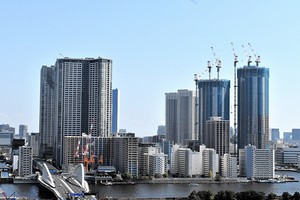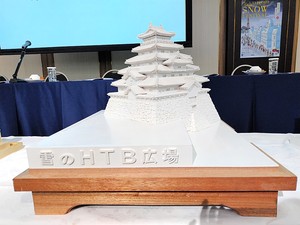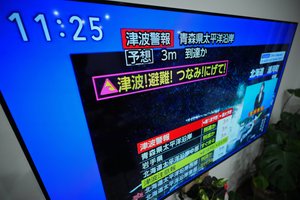Vox Populi, Vox Dei is a daily column that runs on Page 1 of The Asahi Shimbun.
August 10, 2024 at 12:09 JST
 A sign announces the closure of Shirarahama Beach in Shirahama, Wakayama Prefecture, on Aug. 9. (The Asahi Shimbun)
A sign announces the closure of Shirarahama Beach in Shirahama, Wakayama Prefecture, on Aug. 9. (The Asahi Shimbun)
In 1854, one year after the first visit to Japan by Commodore Matthew Perry of the U.S. Navy, a Russian frigate named Diana anchored off Shimoda on the Izu Peninsula southwest of Tokyo.
The vessel’s commander, Adm. Yevfimiy Putyatin of the Imperial Russian Navy, was on a diplomatic mission to negotiate what would become the Treaty of Shimoda of 1855.
Around 9 in the morning or thereabouts, Diana was jolted violently, and then was tossed and spun around by frothing waves rushing landward.
That was the Ansei-Tokai Earthquake of 1854 that originated in the Nankai Trough in the Pacific Ocean.
The megaquake triggered a 6-meter tsunami that swept away 95 percent of coastal homes. A “bakufu” (shogunate government) diplomat in charge of Russian affairs, who witnessed the disaster, reported to the effect, “Black smoke rose, ships were battered, houses collapsed, people screamed. I felt this was what hell must look like.”
But another shock followed the next day, literally. A devastating temblor of a similar scale, which came to be known as the Ansei-Nankai Earthquake, hit Osaka and other parts of western Japan, causing massive damage.
Today, the possibility of a pair of such catastrophic earthquakes, hitting both the western and eastern parts of Japan on the Pacific coast, is what truly terrifies me about the predicted Nankai Trough Earthquake.
The Japan Meteorological Agency issued its first megaquake advisory after a magnitude-7.1 earthquake struck off Miyazaki Prefecture on Aug. 8. Residents of the regions concerned are supposed to remain alert, for a week, to the possibility of a major jolt.
Referring to the advisory, experts say, “The probability of an earthquake is several times higher than usual, but that does not necessarily mean that an earthquake will occur for certain, so please keep up your normal routine.”
These hopelessly indecisive pronouncements underscore the sheer difficulty of earthquake prediction.
Still, the ground under our feet is telling us to be vigilant. Tremors were felt last night in Tokyo and its neighboring prefectures. We should double-check our preparedness.
Many people are probably planning to travel during this coming week. It could save their lives if they take just a minute to make sure, in advance, where they should flee in the event of a tsunami.
--The Asahi Shimbun, Aug. 10
* * *
Vox Populi, Vox Dei is a popular daily column that takes up a wide range of topics, including culture, arts and social trends and developments. Written by veteran Asahi Shimbun writers, the column provides useful perspectives on and insights into contemporary Japan and its culture.




















A peek through the music industry’s curtain at the producers who harnessed social media to help their idols go global.
A series based on diplomatic documents declassified by Japan’s Foreign Ministry
Here is a collection of first-hand accounts by “hibakusha” atomic bomb survivors.
Cooking experts, chefs and others involved in the field of food introduce their special recipes intertwined with their paths in life.
A series about Japanese-Americans and their memories of World War II